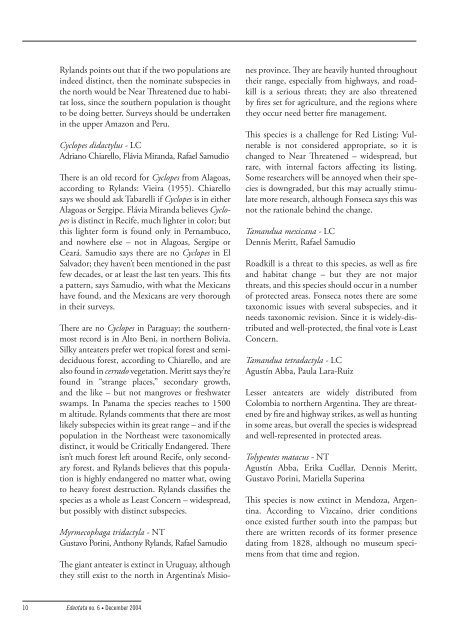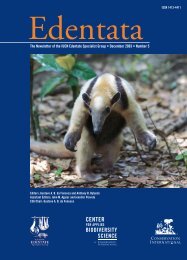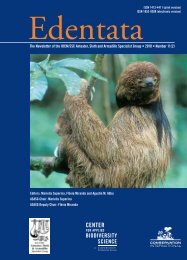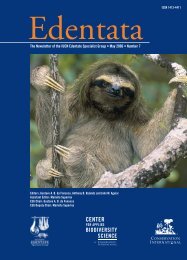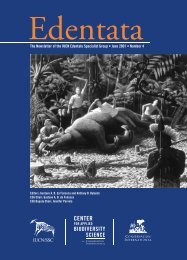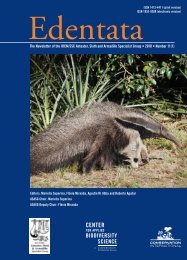Edentata 6 - Anteater, Sloth & Armadillo Specialist Group
Edentata 6 - Anteater, Sloth & Armadillo Specialist Group
Edentata 6 - Anteater, Sloth & Armadillo Specialist Group
Create successful ePaper yourself
Turn your PDF publications into a flip-book with our unique Google optimized e-Paper software.
Rylands points out that if the two populations are<br />
indeed distinct, then the nominate subspecies in<br />
the north would be Near Threatened due to habitat<br />
loss, since the southern population is thought<br />
to be doing better. Surveys should be undertaken<br />
in the upper Amazon and Peru.<br />
Cyclopes didactylus - LC<br />
Adriano Chiarello, Flávia Miranda, Rafael Samudio<br />
There is an old record for Cyclopes from Alagoas,<br />
according to Rylands: Vieira (1955). Chiarello<br />
says we should ask Tabarelli if Cyclopes is in either<br />
Alagoas or Sergipe. Flávia Miranda believes Cyclopes<br />
is distinct in Recife, much lighter in color; but<br />
this lighter form is found only in Pernambuco,<br />
and nowhere else – not in Alagoas, Sergipe or<br />
Ceará. Samudio says there are no Cyclopes in El<br />
Salvador; they haven’t been mentioned in the past<br />
few decades, or at least the last ten years. This fits<br />
a pattern, says Samudio, with what the Mexicans<br />
have found, and the Mexicans are very thorough<br />
in their surveys.<br />
There are no Cyclopes in Paraguay; the southernmost<br />
record is in Alto Beni, in northern Bolivia.<br />
Silky anteaters prefer wet tropical forest and semideciduous<br />
forest, according to Chiarello, and are<br />
also found in cerrado vegetation. Meritt says they’re<br />
found in “strange places,” secondary growth,<br />
and the like – but not mangroves or freshwater<br />
swamps. In Panama the species reaches to 1500<br />
m altitude. Rylands comments that there are most<br />
likely subspecies within its great range – and if the<br />
population in the Northeast were taxonomically<br />
distinct, it would be Critically Endangered. There<br />
isn’t much forest left around Recife, only secondary<br />
forest, and Rylands believes that this population<br />
is highly endangered no matter what, owing<br />
to heavy forest destruction. Rylands classifies the<br />
species as a whole as Least Concern – widespread,<br />
but possibly with distinct subspecies.<br />
Myrmecophaga tridactyla - NT<br />
Gustavo Porini, Anthony Rylands, Rafael Samudio<br />
The giant anteater is extinct in Uruguay, although<br />
they still exist to the north in Argentina’s Misiones<br />
province. They are heavily hunted throughout<br />
their range, especially from highways, and roadkill<br />
is a serious threat; they are also threatened<br />
by fires set for agriculture, and the regions where<br />
they occur need better fire management.<br />
This species is a challenge for Red Listing: Vulnerable<br />
is not considered appropriate, so it is<br />
changed to Near Threatened – widespread, but<br />
rare, with internal factors affecting its listing.<br />
Some researchers will be annoyed when their species<br />
is downgraded, but this may actually stimulate<br />
more research, although Fonseca says this was<br />
not the rationale behind the change.<br />
Tamandua mexicana - LC<br />
Dennis Meritt, Rafael Samudio<br />
Roadkill is a threat to this species, as well as fire<br />
and habitat change – but they are not major<br />
threats, and this species should occur in a number<br />
of protected areas. Fonseca notes there are some<br />
taxonomic issues with several subspecies, and it<br />
needs taxonomic revision. Since it is widely-distributed<br />
and well-protected, the final vote is Least<br />
Concern.<br />
Tamandua tetradactyla - LC<br />
Agustín Abba, Paula Lara-Ruiz<br />
Lesser anteaters are widely distributed from<br />
Colombia to northern Argentina. They are threatened<br />
by fire and highway strikes, as well as hunting<br />
in some areas, but overall the species is widespread<br />
and well-represented in protected areas.<br />
Tolypeutes matacus - NT<br />
Agustín Abba, Erika Cuéllar, Dennis Meritt,<br />
Gustavo Porini, Mariella Superina<br />
This species is now extinct in Mendoza, Argentina.<br />
According to Vizcaíno, drier conditions<br />
once existed further south into the pampas; but<br />
there are written records of its former presence<br />
dating from 1828, although no museum specimens<br />
from that time and region.<br />
10 <strong>Edentata</strong> no. 6 • December 2004


